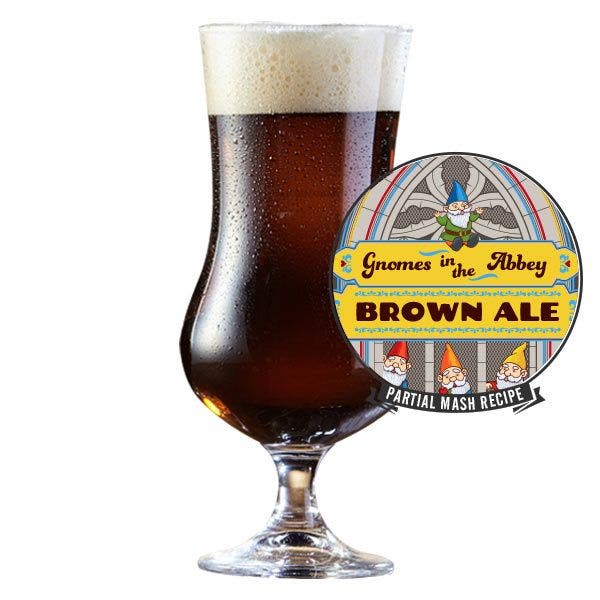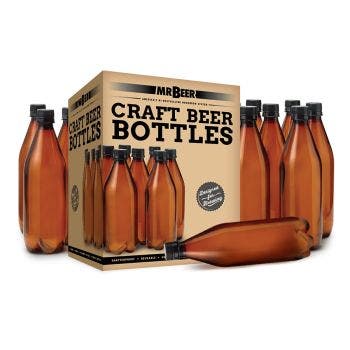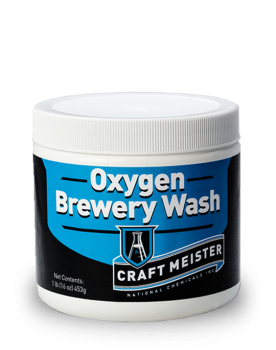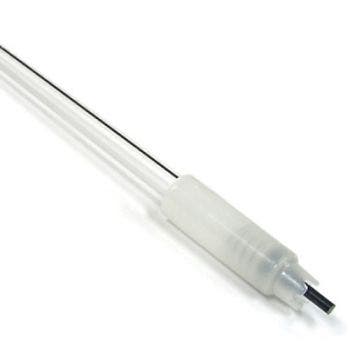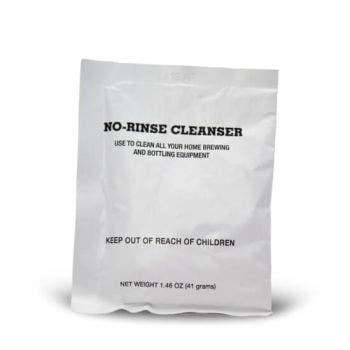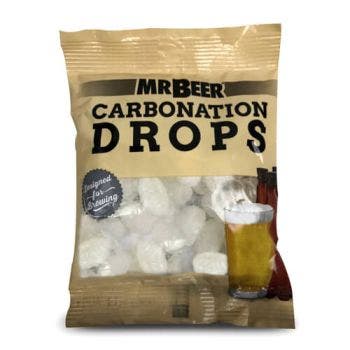Gnomes in The Abbey Brown Ale
Be careful of these Gnomes. These are not the kind to steal your socks, but the kind that will make you party till the break of dawn. After one sip of this surprising smooth, yet strong beer you will be transported into another dimension where Gnomes rule the world. Were time moves slow but the beer goes fast. The more you drink of this brew, the more you might start to look like a Gnome in the mirror. Don't say we did not warn you.
What You Get
2 Canadian Blonde Brewing Extract (HME)
2 Packets of Robust LME
1 Packet of Booster
1 Packet of Vienna Malt
1 Packet of Honey Malt
1 Packet of Chocolate Malt
1 Packet of Crystal 60
1 Packet of Northern Brewer Hops
1 Packet of Oak Chips
3 Muslin Hop Sack
1 Packet of T-58
1 Packet of No-Rinse Cleanser
You Provide
.25 teaspoons of crushed coriander seeds
1oz dark roasted cracked coffee beans
Enough whiskey to cover the woodchips and coffee beans in a small jar
For Fans Of
Lost Abbey Brewery Gnoel De Abbey
Brew Specs
Flavor: Strong
Original Gravity: 1.093
Final Gravity: 1.028
ABV: 8.55%
SRM: (Color): 32
IBU: (Bitterness): 38
STEP 1: Sanitizing
Cleaning is one of the most important steps in brewing. It kills microscopic bacteria, wild yeast, and molds that may cause off-flavors in your beer. Make certain to clean all equipment that comes in contact with your beer by following the directions below:
1. Fill clean keg with warm water to line mark 1 on the back, then add ½ pack (about 1 tablespoon) of No-Rinse Cleanser and stir until dissolved. Once dissolved, the solution is ready to use. Save the remaining ½ of No-Rinse Cleanser because you will need it for bottling.
2. Screw-on the lid and swirl the keg so that the cleaning solution makes contact with the entire interior of the keg, including the underside of the lid. Note that the ventilation notches under the lid may leak solution. Allow to sit for at least 2 minutes and swirl again.
3. To clean the spigot, open it fully and allow the liquid to flow for 5 seconds and then close.
4. Pour the rest of the solution from the keg into a large bowl. Place your spoon/whisk, can opener and measuring cup into the bowl to keep them cleaned throughout the brewing process. Leave them immersed for at least 2 minutes in cleaning solution prior to using.
5. After all, surfaces have been thoroughly cleaned, do not rinse or dry the keg or utensils. Return lid to the top of the keg, proceed immediately to brewing.
STEP 2: BREWING
Brewing beer is the process of combining a starch source (in this case, a malt brewing extract) with yeast. Once combined, the yeast eats the sugars in the malt, producing alcohol and carbon dioxide (CO2). This process is called fermentation.
1. Remove the yeast packet from under the lid of the can of Brewing Extract, then place the unopened cans & LME in hot tap water.
2. Add 8 cups of water to your 1 gallon or larger boiling pot. Add the packet of booster into this water while cool and stir to dissolve. Next, add ALL of the packets of grain to one of the muslin sacks and tie it closed so that the grain has room to flow freely within the sack, and set it aside.
3. Next, heat the pot of Booster water to a temperature range of 155-165 degrees F and hold this temperature. Next, place the grain sack into the hot Booster water and allow it to steep, holding the temperature at 155-165 for 30 minutes.
4. While the grain is steeping, measure out .25 teaspoon of coriander seeds and roughly crack and crush them. Next, Add the packet of Northern brewer hops to the muslin sack and add the coriander seeds in with he hops. Tie the sack closed so that the hops have room to expand within the sack. Set aside.
5. Once the grain water has finished steeping for 30 minutes, turn off the heat and carefully lift the grain sack out of the pot and place it in a colander to drain, while allowing the runoff to flow back into the pot. Do not squeeze. Use one cup of hot water (around 160 degrees) and continue to let the excess liquid run back into your pot. Discard grain bag.
6. Open both packets of LME and add them to your grain water and stir gently until combined. Once combined, return the pot to heat and bring the mixture to a low rolling boil. Once boiling, add the hopsack containing the Northern brewer hops and coriander and allow it to boil for 10 minutes. Once 10 minutes has passed remove the pot from heat.
9. Open the cans of Brewing Extract and pour the contents into the hot mixture in your pot. Stir until thoroughly mixed. This mixture of unfermented beer is called wort.
10. Fill your fermenter with cold tap water to the mark 1 on the back. If using any other fermenter this would be approximately 1 gallon of water.
11. Pour the wort into your fermenter, and then bring the volume of the fermenter to mark 2 by adding more cold water. (If you have a different fermenter top it off to 8.5 liters)
12. Stir your wort mixture vigorously with your sanitized spoon or whisk.
13. Sprinkle the T-58 Dry Ale yeast packet into the keg, and screw on the lid. Do not stir.
Put your fermenter in a location with a consistent temperature between 68° and 78° F (20°-25° C), and out of direct sunlight. Ferment for 21 days.
STEP 3: Adding Extras
Adding extras is the process of adding additional ingredients to a beer which will impart more flavor and aroma in your finished brew.
1. On day 13 of fermentation, add the cracked coffee beans and oak chips to a small bowl or jar and pour just enough whiskey over the top to cover the solids. Cover this and leave it to soak overnight.
2. On day 14, sanitize your hopsack by boiling it in water for 5 minutes, then add the oak chips and coffee beans into the hop sack and carefully add them to the fermenter, along with any extra liquor left in your soaking container.
STEP 4: Bottling & Carbonating
After 21 days, taste a small sample to determine if the beer is fully fermented and ready to bottle. If it tastes like flat beer, it is ready. If it’s sweet, then it’s not ready. Let it ferment for 3 more days (24 total). At this point, it is time to bottle. Do not let it sit in the fermenter for longer than 24 days total.
1. When your beer is ready to bottle, fill a 1-gallon container with warm water, then add the remaining ½ pack of the No-Rinse Cleanser and stir until dissolved. Once dissolved, it is ready to use.
2. Distribute the cleaning solution equally among the bottles. Screw-on caps (or cover with a metal cap if using glass bottles) and shake bottles vigorously. Allow to sit 10 minutes, then shake the bottles again. Remove caps and empty all cleaning solution into a large bowl. Use this solution to clean any other equipment you may be used for bottling. Do not rinse.
3. Add 2 Carbonation Drops to each 740-mL bottle. For 1-liter bottles, add 2 ½ drops; for ½-liter bottles add 1 drop. Alternatively, you can add table sugar using this table as a guide.
4. Holding the bottle at an angle, fill each bottle to about 2 inches from the bottle’s top.
5. Place caps on bottles, hand tighten, and gently turn the bottle over to check the bottle’s seal. It is not necessary to shake them.
6. Store the bottles upright and out of direct sunlight in a location with a consistent temperature between 70°-76°F or 21°-24°C. Allow sitting for a minimum of 14 days. If the temperature is cooler than suggested it may take an additional week to reach full carbonation.
Tip from our Brewmasters
After the primary carbonation has taken place your beer is ready to drink. We recommend putting 1 bottle in the refrigerator at first for 48 hrs. After 48hrs. give it a try and if it is up to your liking put the rest of your beer in the fridge. If it does not taste quite right, leave the bottles out at room temp for another week or so. Keep following this method until your brew tastes just how you like it.
This process is called conditioning and during this time the yeast left in your beer can help clean up any off flavors. Almost everything gets a little better with time and so will your beer.

